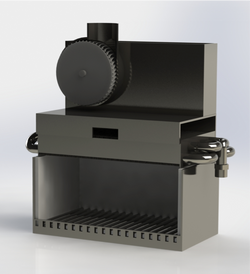Second Year Projects
-
Home Furnace Simulation
Objective: To provide a computer simulation of a home furnace mechanism and detailed 3D models of the furnace's parts and assembly.
 Complete Furnace Assembly |  Furnace, bottom half |
|---|---|
 Furnace, top half |  Main Heat Exchanger |
 Brass Pipe |  Gas Supply |
 Secondary Heat Exchanger |  Burner, Heat Exchanger and Vent Fan |
Steps: I carefully disassembled a real home furnace and accurately measured all the parts. Then I provided CAD models of all the parts using SolidWorks and assembled them to create a 3D modeled furnace. Finally, by using SolidWorks animation I was able to show how a furnace is assembled and how the water heating mechanism works as shown in the video below.
Results and Achievements: I gained a deep understanding of how furnaces work and how they are manufactured. Moreover, I was able to enhance my CAD and modeling skills through providing 3D models of many different parts. This skill was later used in other projects such as the capstone design.
-
Forced Convection Radiator with Automatic Fan System
Objective: To increase the efficiency of radiators that are used as heating systems by utilizing the wasted energy.


Steps: In order to increase the efficiency, the new radiator system incorporated forced convection to transfer heat instead of natural convection. This was achieved by installing small air fans under the radiator that would rotate by a turbine that was in the outlet pipe of the radiator. Different turbine and fan geometries were studied using CFD to ensure optimum results are achieved. A prototype of this system was then built using 3D printing and a real-size radiator as a proof of concept.
Results and Achievements: Through CFD simulations it was concluded that this design would have an approximately 20% increase in efficiency compared to regular radiators. The concept of this design is now patented with patent number IR58803. This self-initiative project was a great learning experience for me and I able to use my CFD simulation skills in later projects.